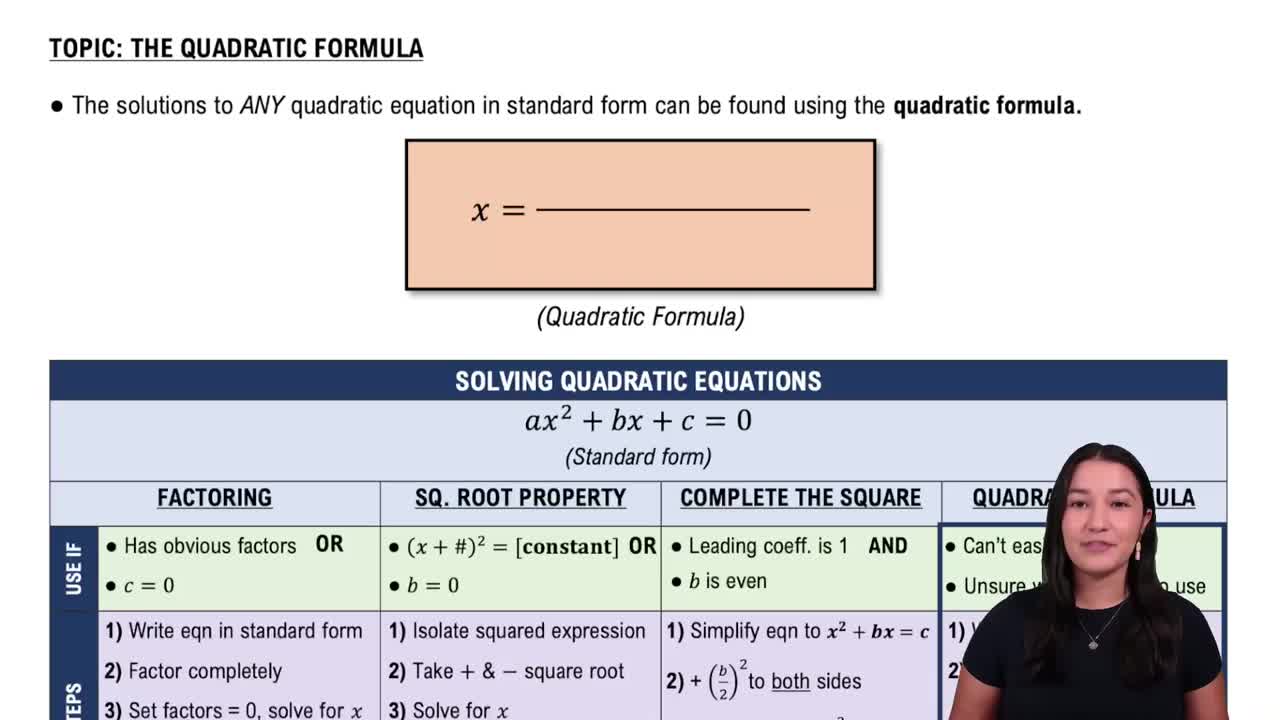Table of contents
- 0. Review of Algebra4h 16m
- 1. Equations & Inequalities3h 18m
- 2. Graphs of Equations43m
- 3. Functions2h 17m
- 4. Polynomial Functions1h 44m
- 5. Rational Functions1h 23m
- 6. Exponential & Logarithmic Functions2h 28m
- 7. Systems of Equations & Matrices4h 6m
- 8. Conic Sections2h 23m
- 9. Sequences, Series, & Induction1h 19m
- 10. Combinatorics & Probability1h 45m
3. Functions
Intro to Functions & Their Graphs
Problem 7b
Textbook Question
Determine whether each statement is true or false. If false, explain why. The graph of y = x^2 + 2 has no x-intercepts.
 Verified step by step guidance
Verified step by step guidance1
<insert step 1> Start by understanding that an x-intercept occurs where the graph of the equation crosses the x-axis, which means y = 0 at that point.>
<insert step 2> Set the equation y = x^2 + 2 equal to 0 to find the x-intercepts: x^2 + 2 = 0.>
<insert step 3> Solve the equation x^2 + 2 = 0 for x. Subtract 2 from both sides to get x^2 = -2.>
<insert step 4> Consider the nature of the equation x^2 = -2. Since x^2 represents a square of a real number, it cannot be negative.>
<insert step 5> Conclude that there are no real solutions for x, meaning the graph of y = x^2 + 2 does not cross the x-axis, confirming the statement is true.>
Recommended similar problem, with video answer:
 Verified Solution
Verified SolutionThis video solution was recommended by our tutors as helpful for the problem above
Video duration:
2mPlay a video:
Was this helpful?
Key Concepts
Here are the essential concepts you must grasp in order to answer the question correctly.
Quadratic Functions
A quadratic function is a polynomial function of degree two, typically expressed in the form y = ax^2 + bx + c. The graph of a quadratic function is a parabola, which can open upwards or downwards depending on the sign of 'a'. Understanding the general shape and properties of parabolas is essential for analyzing their intercepts.
Recommended video:

Solving Quadratic Equations Using The Quadratic Formula
X-Intercepts
X-intercepts are the points where a graph crosses the x-axis, which occur when y = 0. To find x-intercepts for a quadratic function, one must solve the equation ax^2 + bx + c = 0. The nature and number of x-intercepts can be determined using the discriminant (b^2 - 4ac) from the quadratic formula.
Recommended video:
Guided course

Graphing Intercepts
Discriminant
The discriminant is a component of the quadratic formula that helps determine the nature of the roots of a quadratic equation. It is calculated as b^2 - 4ac. If the discriminant is positive, there are two distinct real roots (x-intercepts); if it is zero, there is one real root (a repeated x-intercept); and if it is negative, there are no real roots, indicating the graph does not intersect the x-axis.
Recommended video:

The Discriminant

 5:2m
5:2mWatch next
Master Relations and Functions with a bite sized video explanation from Nick Kaneko
Start learningRelated Videos
Related Practice






